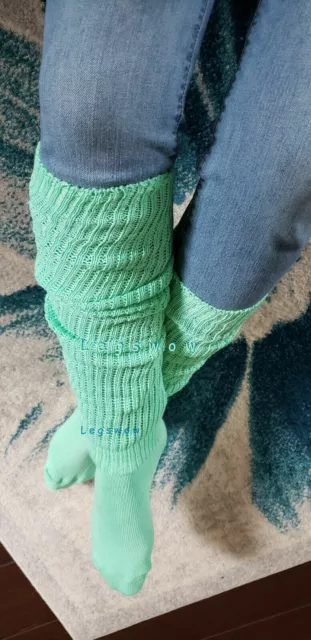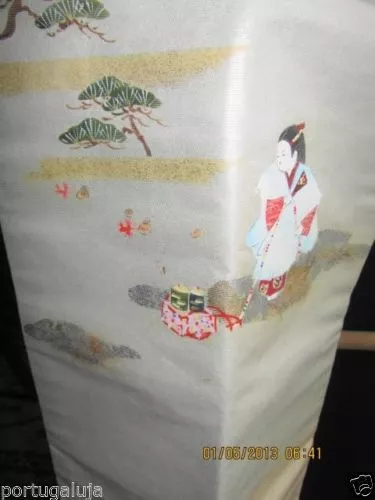MINT/VTG 40s/ WHITE japanese OBI, RECTANGULAR, BED RUNNER, WALL HANGING
Women's obi Women's obi in scale: 1. tsuke/tsukuri/kantan obi 2. hanhaba obi 3. Nagoya obi 4. Fukuro obi 5. Maru obi
The wide women's obi is folded in two when worn, to a width of about 15 centimetres (5.9 in) to 20 centimetres (7.9 in). It is considered elegant to tie the obi so that the folded width is in harmony with the wearer's body dimensions. Usually this means about a tenth of her height. The full width of the obi is present only in the decorative knot, musubi .
A woman's obi is worn in a fancy musubi knot. There are ten ways to tie an obi, and different knots are suited to different occasions and different kimono.
There are many different types of women's obi, and the usage of them is regulated by many unwritten rules not unlike those that concern the kimono itself. Certain types of obi are used with certain types of kimono; the obi of married and unmarried women are tied in different ways. Often the obi adjusts the formality and fanciness of the whole kimono outfit: the same kimono can be worn in very different situations depending on what kind of obi is worn with it
Women's obi types
The Nagoya obi , the most popular type for kimono throughout Japan
Tsuke obi is much shorter than the other types of obi.
The separate bow part of a tsuke obi is attached using a wire hook.
Girl wearing a yukata. A striking effect is obtained by folding the reversible obi to reveal the contrasting underside.
- Darari obi (だらり帯 ? ) is a very long maru obi worn by maiko. A maiko's darari obi has the kamon insignia of its owner's okiya on the other end. A darari obi can be 600 centimetres (20 ft) long.
- Fukuro obi (袋帯 ? , "pouch obi") is a grade less formal than a maru obi and the most formal obi actually used today.
It has been made by either folding cloth in two or sewing two pieces of
cloth together. If two cloths are used, the cloth used for the backside
of the obi may be cheaper and the front cloth may be, for example,
brocade. Not counting marriage outfits, the fukuro obi has replaced the
heavy maru obi as the obi used for ceremonial wear and celebration. A fukuro obi is often made so that the part that will not be visible when worn is of smooth, thinner and lighter silk A fukuro obi is about 30 centimetres (12 in) wide and 360 centimetres (11.8 ft) to 450 centimetres (14.8 ft) long.
When worn, a fukuro obi is almost impossible to tell from a maru obi.]
Fukuro obi are made in roughly three subtypes. The most formal and
expensive of these is patterned brocade on both sides. The second type
is two-thirds patterned, the so-called "60% fukuro obi", and it is
somewhat cheaper and lighter than the first type. The third type has
patterns only in the parts that will be prominent when the obi is worn
in the common taiko musubi.
- Fukuro Nagoya obi (袋名古屋帯 ) or hassun Nagoya obi (八寸名古屋帯 , "eight-inch Nagoya obi")
is an obi that has been sewn in two only where the taiko knot would
begin. The part wound around the body is folded when put on. The fukuro
Nagoya obi is intended for making the more formal, two-layer variation
of the taiko musubi, the so-called nijuudaiko musubi . It is about 350 centimetres (11.5 ft) long
- Hoso obi (細帯 ? , "thin sash")
is a collective name for informal half-width obi. Hoso obi are 15
centimetres (5.9 in) or 20 centimetres (7.9 in) wide and about 330
centimetres (10.8 ft) long
Nagoya Obi
The most convenient obi today is the nagoya obi. First produced in the
city of Nagoya at the end of the Taisho era (1912-26), the Nagoya obi is
lighter and simpler than the fukuro or maru obi. The nagoya obi is
characterised by a portion of the obi being pre-folded and stitched in
half. The narrow part wraps around the waist, while the wider part forms
the bow of the obi tie. When worn, a nagoya obi is tied with a single
fold, while a maru or a fukuro obi, being longer, is tied with a double
fold. Most nagoya obi is less expensive a maru or fukuro obi. Nonetheless,
its design can be stunning. NO RETURNS, REFUNDS, PREMIER BUYERS AND COLLECTORS PLEASE
- Condition: Geisha, zen child and mountain sceneoff white, long , true vintage, taisho obi, sash, bed runner, with zen dolls, bamboo country scene, placed throughout, selectively, no smudges, gold, silver, zen doll, placed strategically, antique, medium weight silk both exterior and interior, iconic images in silk screen, 1 off, rare for an antique obi to be in rinzen silk, off white,
- Region of Origin: Japanese
- Product: ANTIQUE OBI
- Age: 1900-1940
- Primary Material: MEDIUM WEIGHT SILK BROCADE
- Sub-Type: OBI/kimonoelt/edrunner
- Original/Repro: Antique Original
PicClick Insights - MINT/VTG 40s/ WHITE japanese OBI, RECTANGULAR, BED RUNNER, WALL HANGING PicClick Exclusive
- Popularity - 0 watchers, 0.0 new watchers per day, 1,537 days for sale on eBay. 0 sold, 1 available.
- Best Price -
- Seller - 267+ items sold. 0% negative feedback. Great seller with very good positive feedback and over 50 ratings.
People Also Loved PicClick Exclusive

vintage retro original obi Japanese belt gold silver brocade 12" x 142"
£14.99 0 Bids 6d 9h
vintage retro original obi Japanese belt gold orange pattern 12" x 142"
£19.99 0 Bids 6d 9h
vintage retro original obi Japanese belt gold orange pattern 12" x 142"
£14.99 0 Bids 2d 1h
Mint,vintage late 40s Fukoro silk cream floral Long japanese obi, bedrunner
£45.00 Buy It Now 27d 5h
Vintage Japanese kimono's belt (Obi) collectable silk fabric
£40.00 Buy It Now 2d 0h
Long Loose Thigh High Slouch Socks Over The Knee Japanese School Girl Cosplay 70
£42.83 Buy It Now 1 watcher
1 watcherLong Loose Thigh High Slouch Socks Over Knee Japanese School Girl Cable Knit OTK
£42.83 Buy It Now
Long Loose Thigh High Socks Over Knee Japanese School Girl Cable Knit Cosplay
£42.83 Buy It Now
Long Loose Thigh High Slouch Bubble Socks Over The Knee Japanese School Girl 70"
£42.83 Buy It Now


